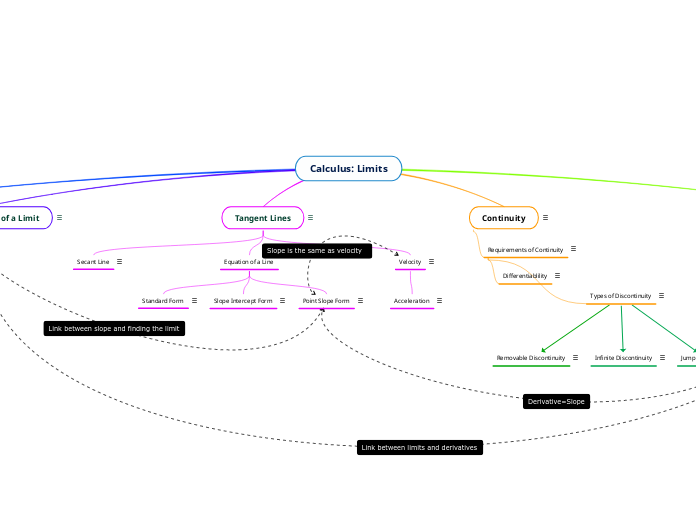Calculus: Limits
Derivative of a Function
The derivative of a function is the limit of (f(x+h)+f(x))/h
This is how the limit of a function is related to finding the derivative of a function.
Continuity
For a function to be continuous at a number 'a' the limit of f(x) as a gets closer to a must equal f(a)
Requirements of Continuity
- f(a) is defined at 'a'
- the limit of f(x) as x gets closer to a exists
- the limit of f(x) as x gets closer to a equals f(a)
Types of Discontinuity
If 'f' is a function on an open interval containing 'a', then we can say 'f' is discontinuous at a if 'f' is not continuous at a.
Jump Discontinuity
Occurs if the limits from the right and left are different and not equal.
Infinite Discontinuity
Occurs if the function goes to infinity or negative infinity at a.
Removable Discontinuity
Occurs if we can redefine f(x) at a to a single number. (like a hole)
Differentiablility
A function will not be differentiable at point 'a' if
- There is a cusp or kink at a.
- The function is discontinuous at a.
- There is a vertical tangent at a.
- The function does not exist at a.
Tangent Lines
A tangent line touches a curve at or near a point P.
Velocity
Velocity is equal to the change in position over the change in time.
V(t)= (S(t2)-S(t1)) / (t2-t1) which is the same as equation as finding the slope.
Acceleration
The rate of change of velocity is acceleration. Or acceleration is the derivative of velocity.
Equation of a Line
Point Slope Form
y-y1=m(x-x1) may also be written as y-f(x1)=m(x-x1)
m=slope=(f(x2)-f(x1)) / (x2-x1)
Slope Intercept Form
y=mx+b
m=slope=(f(x2)-f(x1)) / (x2-x1)
Standard Form
Ax+By=C
m=slope=(f(x2)-f(x1)) / (x2-x1)
Secant Line
A secant line touches a curve at more than just one point.
Precise Definition of a Limit
The limit is what happens as the function gets closer and closer to a specific number. The limit of f(x) as x approaches 'a' is L. How far away can you get the delta away from 'a' and still make the epsilon true.
Link with derivatives: We can use the limit of a function to find the derivative by taking into account the change in 'h'. The derivative of a function is the same as taking the limit as 'h' approaches 0 of (f(x+h)+f(x))/h.
Link with slope: Using a process similar to finding the limit of function by looking what value it gets closer to from each side we can use this to also find the slope of a tangent line or the derivative of the function.
Limit Laws
We can use the limit of a function to find the derivative by taking into account the change in 'h'. The derivative of a function is the same as taking the limit as 'h' approaches 0 of (f(x+h)+f(x))/h.
Power/Fractional Power
If you are finding the limit of a function and the function is raised to a power, first find the limit of the function and then raise the answer to the appropriate power.
Quotient
If one function is being divided by another and you want the limit then all you have to do is take the limit of each individually and divide them by each other.
Product
If two functions are being multiplied together and you want the limit, then all you have to do is take the limit of each function individually and then multiply them together.
Constant
The limit of a constant is just the constant
Constant Multiple
If you are taking the limit of a function and there is a constant in front you just pull it out to the front and leave it alone and then take the limit of the function and multiple it by the constant.
Sum/Difference
When two functions are being added or subtracted from each and you want the limit, you just take the limit of each function individually and then add or subtract them from each other depending on the problem.









